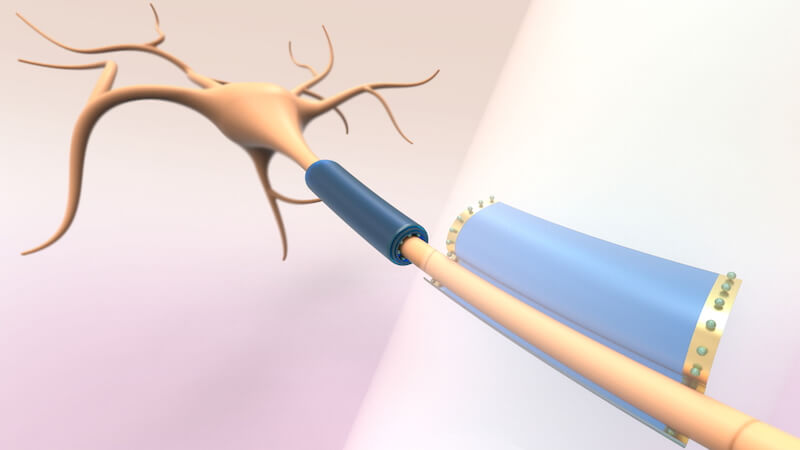
Researchers at the Massachusetts Institute of Technology (MIT) have developed tiny wearable devices that can specifically wrap human cells. They are said to help against diseases such as multiple sclerosis.
Tiny wearable devices that, like fitness trackers, can act directly on human cells on the body: This could soon become a reality. Because that’s exactly what we’re currently working on Researcher at the Massachusetts Institute of Technology (MIT).
They have developed tiny, flexible devices that can surround individual nerve cells without damaging them. The so-called wearables are made of a soft polymer called azobenzene. They react to light and can be precisely controlled by the light dosage and direction.
Due to their small size, it is possible that the devices themselves can envelop the fine, often curved structures of nerve cells. The researchers’ goal: to treat neurological diseases such as multiple sclerosis. The wearables should improve the electrical conductivity between nerve cells.
Wearable human cell devices
The special thing about the devices is their ability to react to light. This allows them to wrap tightly around neurons. The researchers have discovered that they can precisely control the size and shape of the coil using the light intensity. This makes it possible to tailor the devices exactly to the desired shape of the nerve cells.
The application goes beyond just measuring. Since azobenzene has an insulating effect, the devices could even serve as an artificial myelin layer. This is a natural layer that is responsible for signal transmission in the nerves. In diseases such as multiple sclerosis, in which myelin breaks down, wearables could help restore the functionality of the nerve pathways.
The future of neurobiological research
Research is just beginning, but the possibilities seem enormous. By combining electrical and optical materials, wearables will serve other purposes in the future. Everything seems possible, from targeted stimulation to the transmission of signals.
This would make it possible to develop neurological therapies that were previously unimaginable. The researchers hope that their devices can target specific cell types using molecular coatings. This approach could transform medicine forever by allowing doctors to treat specific diseases directly at the cellular level.
Also interesting:
- Researchers break the law of physics: solar cell with 60 percent efficiency
- Researchers want to give plants a “brain” – using light signals
- Research: AI develops more creative ideas than 50 scientists combined
- Researchers are increasing the lifespan of liquid batteries – with air-stable molecules
The article Curing MS? Researchers develop wearable devices for human cells by Felix Baumann appeared first on BASIC thinking. Follow us too Facebook, Twitter and Instagram.
As a Tech Industry expert, I am extremely excited about the development of wearable devices for human cells in the search for a cure for Multiple Sclerosis (MS). This innovative approach has the potential to revolutionize the way we monitor and treat the disease, offering real-time insights into cellular behavior and enabling personalized treatment plans.
The ability to track and analyze the activity of human cells in real-time using wearable devices opens up new possibilities for understanding the underlying mechanisms of MS and developing targeted therapies. This technology could provide a deeper understanding of how the disease progresses at the cellular level, leading to more effective treatments and potentially even a cure.
Furthermore, the development of wearable devices for human cells showcases the power of technology in advancing medical research and improving patient outcomes. By harnessing the capabilities of these devices, researchers can gather valuable data that was previously inaccessible, ultimately accelerating the pace of discovery and innovation in the field of MS research.
Overall, I believe that the development of wearable devices for human cells represents a significant step forward in the quest for a cure for MS, and I am eager to see how this technology continues to transform the landscape of healthcare and biotechnology.
Credits